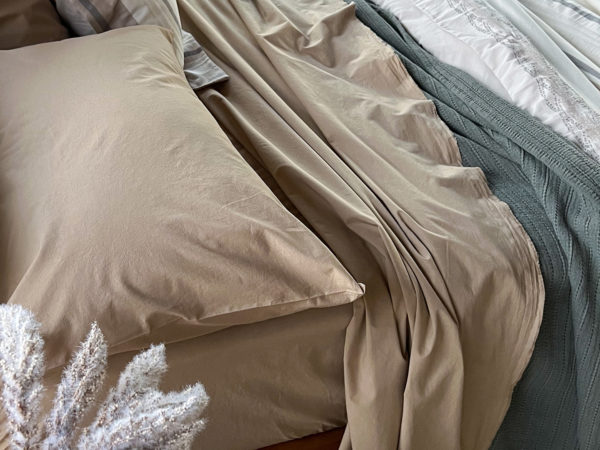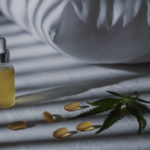Healthy Fabrics For Home And Closet

Are synthetic fabrics harmful to my family’s health? Are there safer, natural options?
When early humans first felt the need to put on clothing, they worked with what they had. The earliest garments were created from animal skins and furs or from simple fabrics made of banana leaves or tree bark. Later, with the cultivation of cotton and flax (for linen), those fibers were used for clothing. Fabrics and designs became more sophisticated over time, with natural materials being the only ones available until relatively recently. In 1938, when DuPont released the first totally synthetic material – nylon – that all changed. The result has been a century of increasingly convenient, but also steadily more toxic, material in our clothing, furniture, and home goods. It’s not a bad time to take stock of how far we’ve come and whether it is time to change course.
The appeal of synthetic garments is clear – they resist stains, don’t lose their shape, don’t wrinkle, and are not vulnerable to moths – so it’s no surprise that nearly 70 percent of clothing today is made of synthetics, such as elastane, nylon, and acrylic. If you have sensitive skin, you may already know about textile dermatitis, a rash that may be caused by fabrics themselves or one of the many chemicals used in their manufacture. Those chemicals help protect clothes from stains and wrinkles, but they can be extremely irritating to the skin. (Infant skin is especially delicate, which is why baby clothing is often made from pure cotton.)
Synthetic garments also require fossil fuels to manufacture them, and they create pollutants downstream (literally). Nylon and other synthetic materials eventually enter the world’s waters as microplastics, which interfere with photosynthesis in plants and are ingested by marine life. They make their way into us when we eat seafood contaminated with them.
One 2021 study of microplastics assessed seven species of fish from Lake Ontario and Lake Superior; researchers reported finding the highest concentration of them and other synthetic microparticles ever identified in bony fish. Although the health hazards of ingesting microplastics in the fish we eat are not yet completely understood, it’s a risk I would rather avoid.
Synthetic fabrics also find their way into our homes in other ways. Most carpets these days are made of nylon or polyester, and much upholstery is now synthetic. Both furniture and carpet go through a period of “off-gassing,” during which they release potentially toxic fumes into the air we breathe.
So, what do we do? For starters, make it a point to look for natural fabrics when shopping for clothes or rugs. Yes, it can be difficult, but more and more designers and producers are working with organic or sustainable fabrics, and it’s worth the effort. Wool or cotton rugs, especially those without dyes or added chemicals to resist stains, are healthier choices underfoot. In clothing, your plant-based choices are no longer limited to cotton and linen – here are some alternatives that are starting to show up in garments that are healthier for you as well as for the planet:
Hemp
Industrial hemp has been grown for thousands of years and is known for its natural resistance to pests and weeds, its short growing cycle, and the cost-effectiveness of production. Although it is not the same as cannabis, it’s a close enough cousin to have caused confusion, which effectively resulted in a ban on the cultivation and distribution of hemp in the United States in 1937. With the passage of the 2018 Farm Bill, U.S. farmers may now grow industrial hemp, and it’s widely available in garments manufactured elsewhere. Clothes made from hemp are lightweight and breathable and are as easy on the skin as they are on the environment.
Kapok
Fibers of the fast-growing kapok tree are excellent for making garments that are lightweight, soft, and water-resistant. The fibers are short, making them difficult to spin into fabric, so clothes made from kapok are often blended with cotton. Kapok has excellent insulating properties and is extremely buoyant, making it useful in lifejackets and other flotation devices. It is highly flammable so it’s not a good choice for upholstery yet. Researchers are looking into strategies to make kapok more flame-resistant.
Cotton
There’s a reason baby clothes are so often made of 100 percent cotton – it’s soft and gentle on the skin and rarely causes any kind of irritation or rash. When grown and produced organically, cotton is also relatively easy on the environment. Cotton, however, is more typically produced using methods that reduce its benefits – it requires a lot of water to grow, plants are often doused in pesticides, and fabrics may be bleached with chlorine before being dyed. If you’re shopping for cotton clothes or bedding, look for 100 percent organic products or a cotton-kapok blend.
Flax/Linen
Linen is made from fibers of the flax plant, and it’s one of the oldest (if not the oldest) source of fabrics in history. It requires far less water to grow than cotton, so it’s considered more sustainable. Linen clothing is lightweight, breathable, and quick to dry. It also wrinkles easily and is more expensive than cotton. It does make for lovely tablecloths and other home linens.
A Word About Regenerated Cellulose
Often found under the brand names Tencel or Cupro, regenerated cellulose (also called modal, or lyocell) is not a naturally occurring material but a hybrid of natural and synthetic fabrics. Tencel is made from wood pulp (from sustainably harvested beech, birch, eucalyptus, and spruce trees); Cupro is a byproduct of cotton production. The resulting materials are soft, wrinkle resistant, and breathable, and they make soft and comfortable bedsheets – but keep in mind that they are not natural fabrics. Cupro isn’t manufactured in the United States because the process doesn’t meet our air and water protection standards. Companies that produce these materials are not the manufacturers of the end product garments, so it’s not clear what chemicals or dyes may be present in the finished product. Use with caution.
See also: Natural Fibers for Your Home
Andrew Weil, M.D.
Sources
Zheng X, Liu X, Zhang L, Wang Z, Yuan Y, Li J, Li Y, Huang H, Cao X, Fan Z. Toxicity mechanism of Nylon microplastics on Microcystis aeruginosa through three pathways: Photosynthesis, oxidative stress and energy metabolism. J Hazard Mater. 2022 Mar 15;426:128094. doi: 10.1016/j.jhazmat.2021.128094. Epub 2021 Dec 17. PMID: 34952496. sciencedirect/science/article/abs/pii/S0304389421030636
Munno, K., Helm, P.A., Rochman, C., George, T., Jackson, D.A. (2022). Microplastic contamination in Great Lakes fish. Conservation Biology, 36, e13794. doi/10.1111/cobi.13794 conbio.onlinelibrary.wiley/doi/full/10.1111/cobi.13794
Ahmed ATMF, Islam MZ, Mahmud MS, Sarker ME, Islam MR. Hemp as a potential raw material toward a sustainable world: A review. Heliyon. 2022 Jan 13;8(1):e08753. doi: 10.1016/j.heliyon.2022.e08753. PMID: 35146149; PMCID: PMC8819531. pubmed.ncbi.nlm.nih/35146149/
Jiang XL, Tang RC. Phosphorylation of Kapok Fiber with Phytic Acid for Enhanced Flame Retardancy. Int J Mol Sci. 2022 Nov 29;23(23):14950. doi: 10.3390/ijms232314950. PMID: 36499278; PMCID: PMC9737048. pubmed.ncbi.nlm.nih/36499278/












